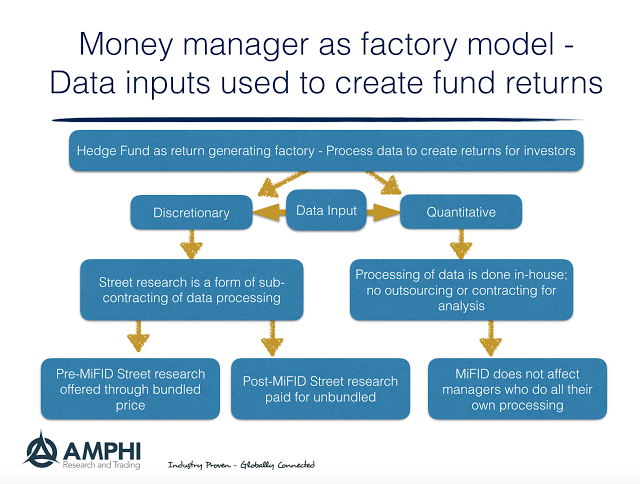MiFID II is coming with less than four months to go until the start date in January 2018, yet money mangers and hedge funds are scrabbling to find the right regulatory structure and the right way to manage the costs of the business. MiFID requires an unbundling of brokerage from research costs. Asset managers will either have to pay for research or bill clients. Many managers have yet to make or disclose their intentions on how research costs will be handled. A topic that has not been fully covered is an understanding of the cost generating the investment returns based on the process employed.
We can start with a simple discussion model of return generation as the output from a factory. The money manager is the return factory that processes information inputs to generate returns. A key question is where do those inputs come from and who pays for the raw material. The raw material can be data and news. The data could be price feeds, fundamental macro information, or company income and balance sheets to name just a few sources. This raw material generally has to be processed inside the factory to generate ideas, form valuations, and create opportunities.
Some raw material needs a lot of processing while others has already been refined and needs little or no processing. The value-added of the manager is his ability to process data and generate a better return output. The data coming into these return factories is the same, but different factories have varying skill at processing the data.
Returns can be generated through a disciplined quantitative investment process with inputs like price and macro fundamental data. This systematic process needs monitoring, but runs like a machine. (You can think of the modern factory which uses robotics on the shop floor. It needs limited human intervention.) The input is raw data with all of the fabrication done in the factory through statistical analysis. The cost of this data is relatively cheap with most of the value-added done through the refining process.
In this case, there is little need for research from brokers because the raw data are readily available from exchanges and the processing is done in-house. There is no deep link between research and execution because there are no research services from the Street that are used in quant programs.
An alternative factory approach is a discretionary investment process which is more akin to an artisan or craftsman. The emphasis is not on bulk processing of raw data but deeper analysis on specific information like firm details which may include company meetings. This work takes more time, and data that is refined or pre-processed is especially helpful. In this model, brokerage firms act like subcontractors or suppliers of research, ideas, and analysis. The efficiency of the discretionary process is in the link with subcontractors or the outsourcing of research. Here the street may provide important contracting services and is a supplier to the hedge fund factory of preprocessed or semi-finished data. This preprocessed information is then used by the fund manager to generate a final product which are the portfolio returns of the fund.
The core issue is the value of subcontracting relative to the price that is paid for this service. The money manger gets this subcontracting though a bundled price with execution. More execution should go to subcontractors who provide more value-added, but the cost of this contracting arrangement is not always clear, direct, or transparent. Good managers should be able to track the quality of subcontracts, poor managers will not. If the subcontractor provides high quality work, then a price will be found for the services. If the quality is poor, then the return factory may reject the input and not use the poor quality or pay for the contracting. Quality assurance may say that the preprocessed data from street research is not useful; however, contracting saves the factory from doing on the data processing in-house.
Unbundling will mean that managers will not accept poor quality research that was given as part of execution fees. This is a positive welfare benefit, but still leaves the question of how to pay for good subcontracting. It is a service that is used to enhance the return factory overall product output. It is not just data, but prefabricated analysis usually done inside the firm. Should investors have to pay for this processing? Is the value of the manager his ability to process raw data or his ability to make decisions on processed data?
Clearly, all in-house processing firms like quantitative shops will not be greatly affected by this. Fundamental shops focused firm-specific analysis could be hit harder if the work now has to be done in-house. Thinking about money manager as a factory firm no different than other industries makes some these questions easier to address.


